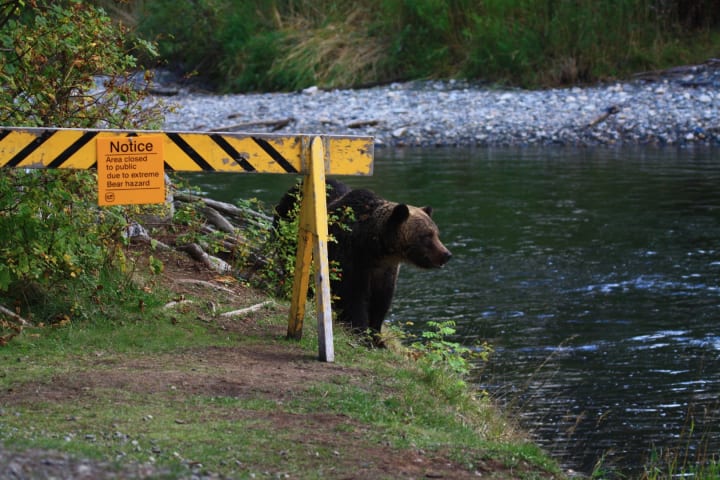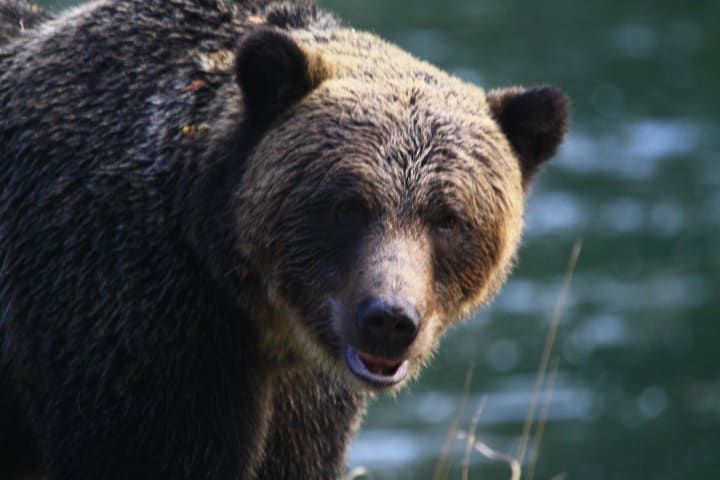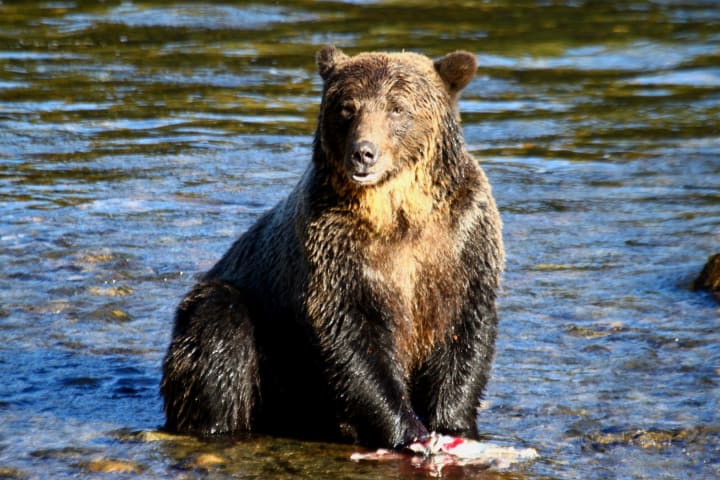Grizzly Bears in the Great Canadian Wilderness
Can bears and people coexist?

“Stand back. She’s coming.”
We moved. Gathering up bags and tripods, we stepped back from the river. A random assortment of strangers, gathered in a dusty pullout next to the highway for a singular purpose. Biting black flies buzzed around our heads, but no one paid any attention. There was a tension in the air you could feel, the thrill of excitement and not a small amount of fear as we backed up.

And the bear came down the banks of the river. Reaching the barrier with its comical sign warning about the presence of bears, she paused and sniffed its edge. Not big by grizzly standards, perhaps. But powerfully muscled and armed with claws that protruded visibly from the coarse fur of her huge paws.
The bear strolled out in front of us, barely thirty feet away. Coming to a halt, she looked at each of us in turn. Her heavy flanks swelled and contracted as she breathed, her open mouth showing formidable fangs as she panted in the September heat. Then, she turned. Camera shutters clicked and whirred as she lumbered toward the bank of the river and plunged into the cool water.

It's the salmon that give life to these forests. Swimming up from the sea, the fish return to the rivers and streams where they themselves were born to play out the final stage of their lives. And they bring life with them. To the animals that live along the coast of British Columbia, the annual fall salmon run is everything. Bald eagles swoop down on the rivers like a bomber squadron, hooking flailing fish in their talons. Seals gather in the estuaries, chasing the panicking salmon through the steel-colored water. Ocean nutrients from the bodies of the fish are part of what causes the trees in this vast temperate rainforest to grow so big.
And the bears come for the feast.

When the salmon run is over, the bears will hibernate. That means the fish are critical to helping them put on enough weight to survive the winter. A coastal grizzly bear can weigh up to 1500 pounds, a colossal monster of teeth and muscle and fur.
And yet, grizzly bears tend to avoid us. In the mountains and the forests, they shy away from humans. It takes the miraculous magic of the salmon run to bring them down to the valley where people live. That's why we were there.

Bella Coola lies on an inlet of the ocean 400 kilometers north of the city of Vancouver. However, the only road into the town swings way to the east before turning back to the coast, making a drive of nearly a thousand kilometers. We had done it in a single day, a punishing 13-hour trip that took us from the verdant greenery of BC's Lower Mainland through the arid mountainous interior before turning back to the lush coast again. Bella Coola sits just south of the Great Bear Rainforest, a colossal area of wilderness of over six million hectares that makes up the world's largest temperate rainforest.
And the steep mountains and glittering fjords of the British Columbia coast are still sparsely populated. Bella Coola retains a kind of frontier feel, a handful of villages surrounded by million miles of nothing. There are no chain stores here. No traffic lights. The valley is home to around two thousand people, and can only be reached by ferry or by what's been classified as one of North America’s most dangerous highways.
It's not just the road that's dangerous. The Bella Coola Valley is almost unique for having such a high population of grizzly bears close to human settlement. Bears and people don't make great neighbors, and managing conflict between the two species is an issue that is as pressing here as anywhere else on earth.
But the presence of the bears is the main source of much-needed tourist revenue for the valley. The salmon run produces a short-lived boom. The town's few hotels and guesthouses are booked solid. People come from across the country and around the world to hang out in the gravel pullout between the highway and the river and wait for the Bears to appear. They always do.
Besides humans, the biggest danger a grizzly bear faces is another grizzly. For that reason, the bears spread themselves out. After the lone female had been and gone, we waited for hours. The biting flies became more of a nuisance now that there was nothing to distract us from them. Our fellow tourists applied bug spray and sunscreen and sought out patches of shade to shelter from the sun. Often, photographing wildlife is a question of patience as much as it is of luck. Sometimes, all you can do is find the right place, then sit and wait for the right time.
Abruptly, the drowsy afternoon was shattered by another murmur of excitement. Further down the stony banks of the river, someone spotted something. Another bear, only not alone this time. This time, it was a female with two cubs.
Feet kicked up dust. Camera shutters rattled. Planting my cheap tripod on the uneven gravel, I watched the grizzly family make its way along the river. The mother led the way, sniffing among the rocks for dead and dying fish. At the back, one of her cubs was distracted by some morsel. Beads of river water clung to his coat, and the sun caught in the pale fur on his head as he turned to look in our direction.
It was an arduous journey into the valley, and an equally arduous one to leave it again when our vacation was over. But it was all worth it for a once-in-a-lifetime encounter with these impressive animals.
About the Creator
Ryan Frawley
Towers, Temples, Palaces: Essays From Europe out now!
Novelist, entomologist and cat owner. Ryan Frawley is the author of many articles and stories and one novel, Scar, available from online bookstores everywhere.






Comments
There are no comments for this story
Be the first to respond and start the conversation.